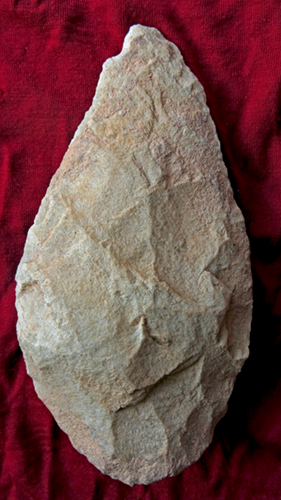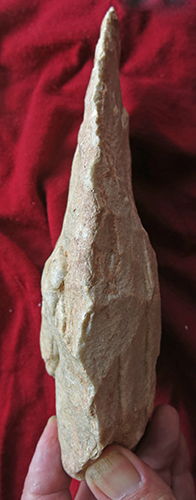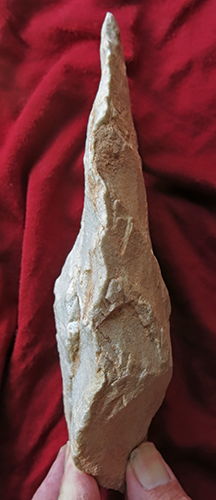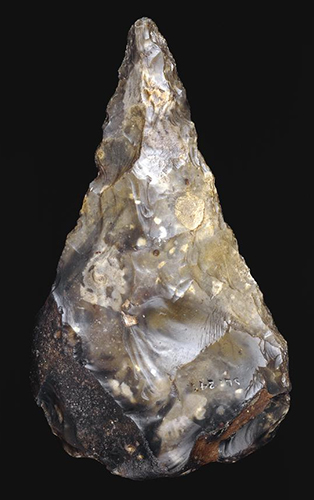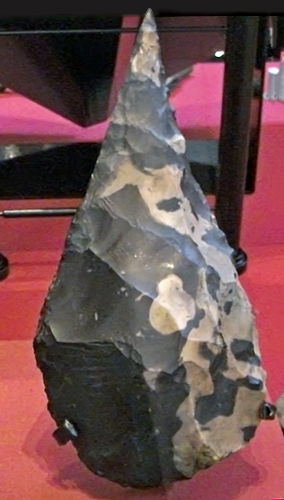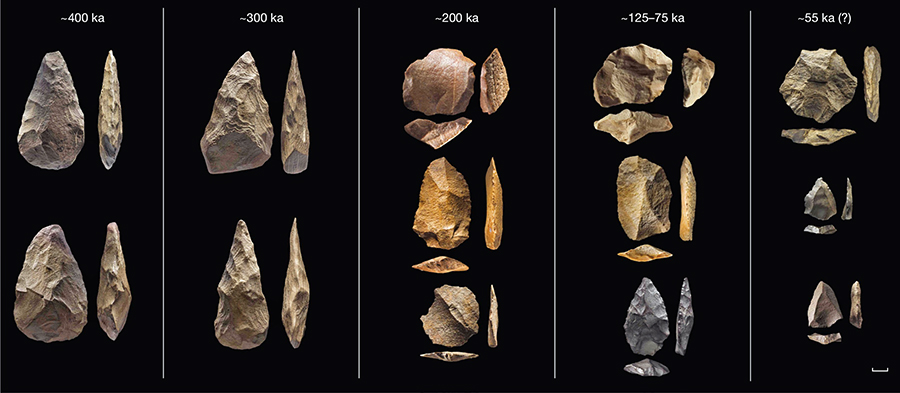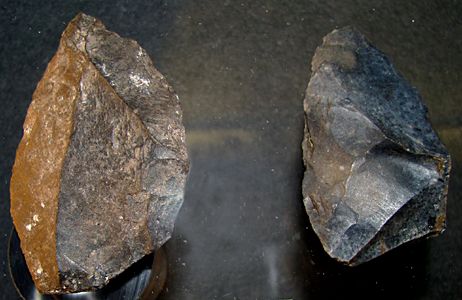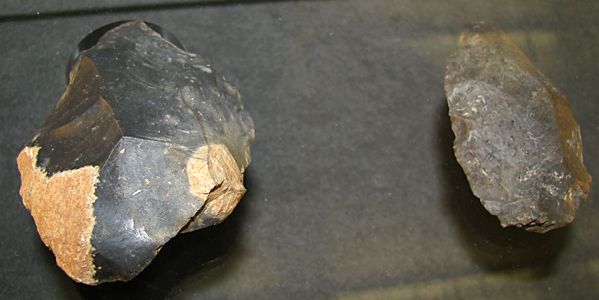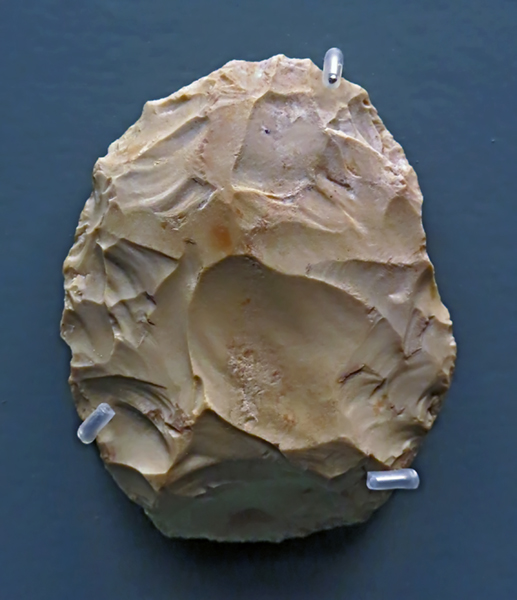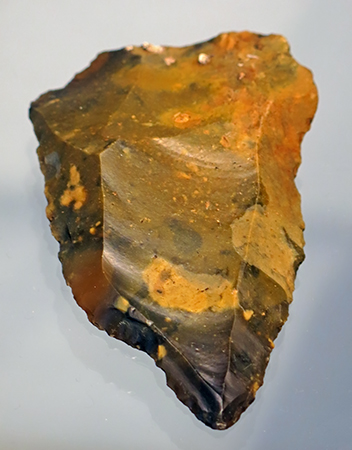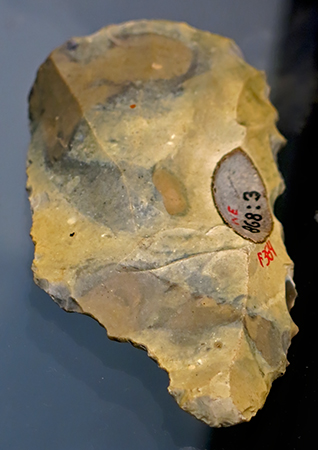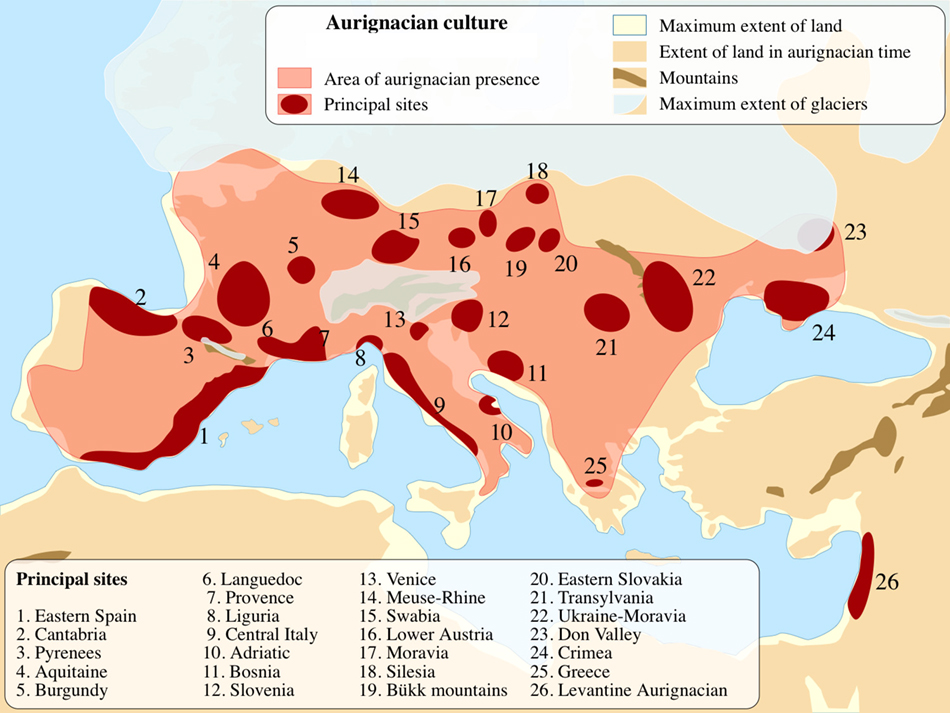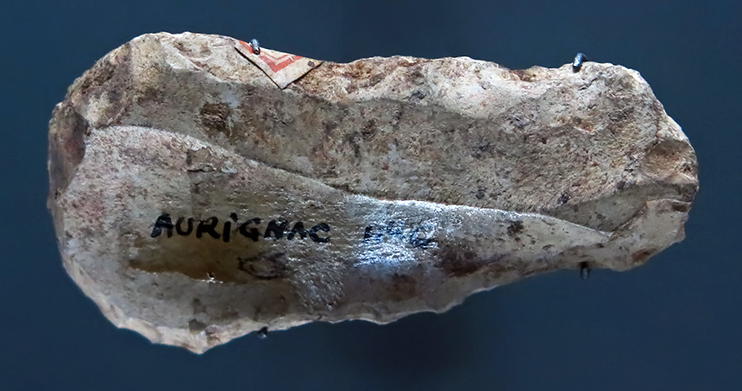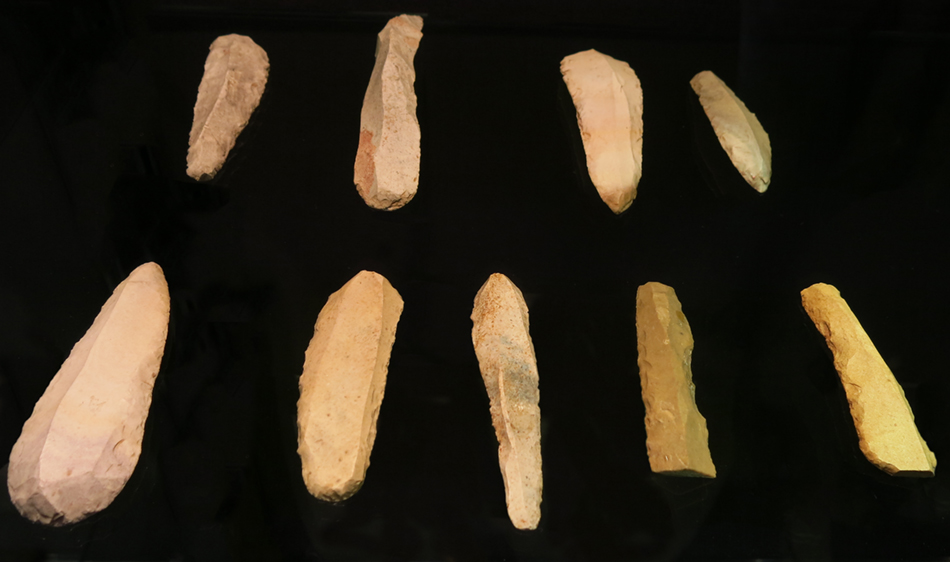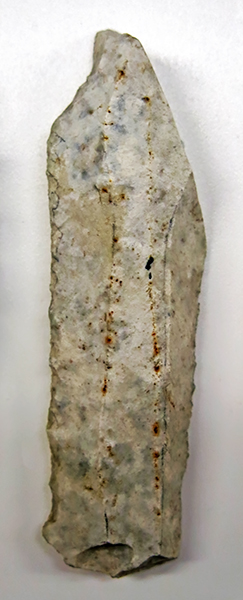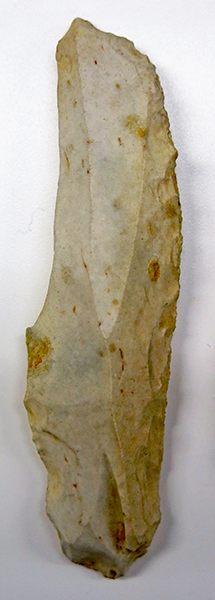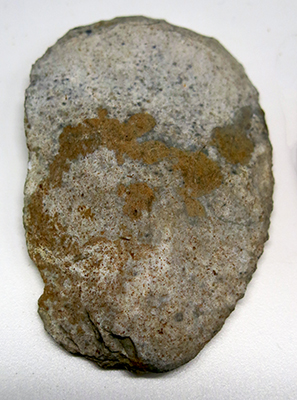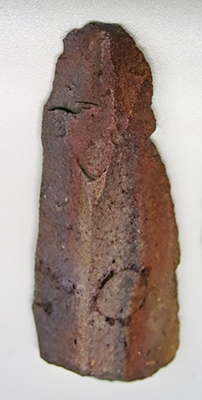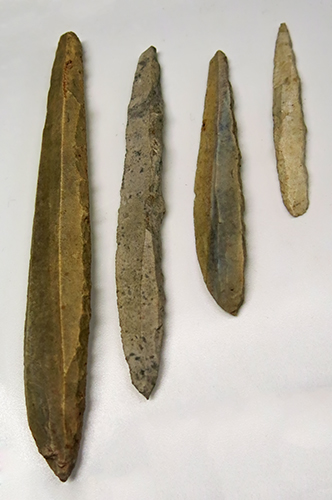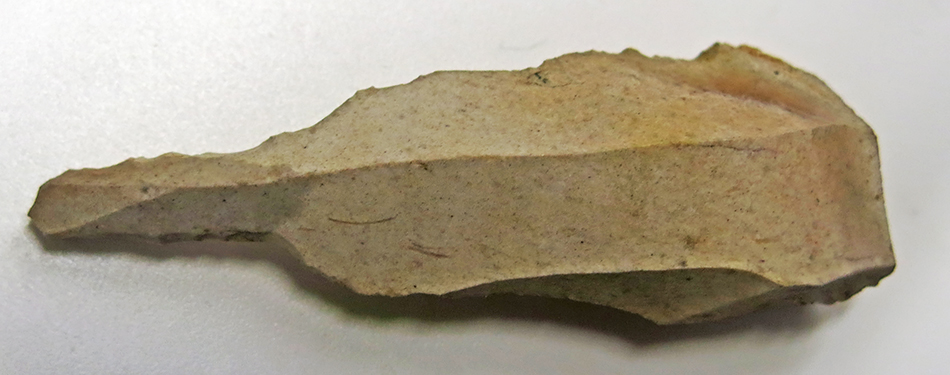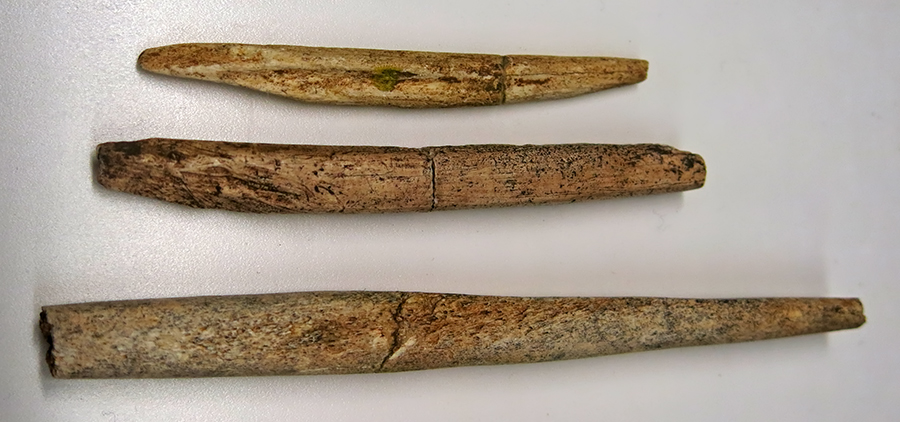Back to Don's Maps
The History and Development of Stone Tools
Choppers
The earliest stone tools are choppers, also characterised as Olduwan tools. Choppers are quickly and easily made by hitting a large pebble found in a river bed against a larger rock, and creating a simple sharp edge. In a few minutes you can have a serviceable tool for helping with the skinning of game, cutting up an animal carcase, and breaking bones to get at the marrow.
But they are heavy, not necessarily easy to hold in the hand, and usually not very sharp, since their working edges are short, and not often equipped with sharp angles. But they can be used to butcher game and cut wood if necessary.
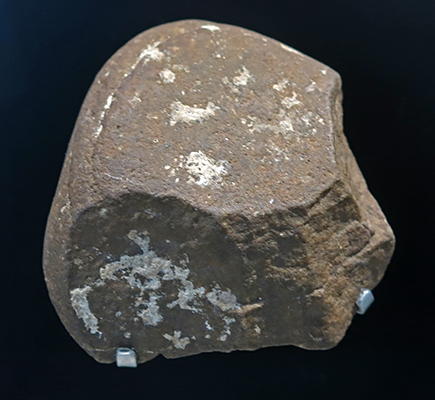
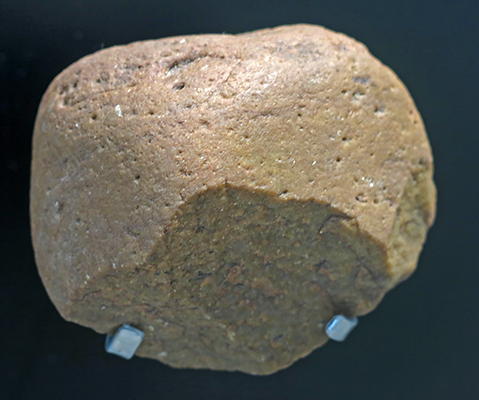
Choppers, the oldest worked stone implements.
These are from Gabarones, Botswana, and are dated at 2 500 000 BP.
Photo: Don Hitchcock 2014
Source and text: Original, Københavns (Copenhagen) Museum, National Museum of Denmark

A chopper is a tool made quickly and easily from a river pebble by striking off a few flakes to make a useable edge. They are often referred to as being from the Oldowan culture.
From 'Ubeidiya, Israel, circa 1 400 000 BP.
Photo: Don Hitchcock 2015
Source: Facimile, Monrepos Archäologisches Forschungszentrum und Museum, Neuwied, Germany
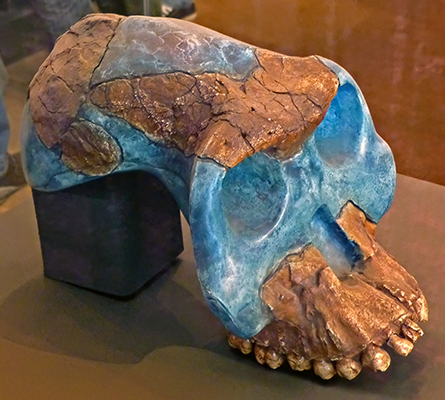
The term Oldowan for choppers is taken from the site of Olduvai Gorge in Tanzania, where the first Oldowan stone tools were discovered by the archaeologist Louis Leakey in the 1930s.
It is not known for sure which hominin species created and used Oldowan tools, but its emergence is often associated with the species Australopithecus garhi, shown at left.
The use of choppers flourished with early species of Homo such as Homo habilis and early Homo erectus.
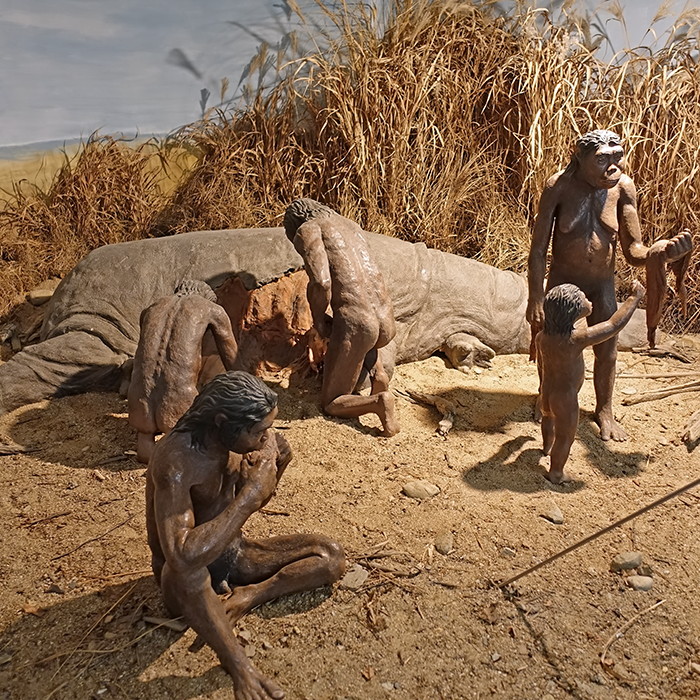
Diorama of Homo habilis at a dead hippo. It is a scientific reconstruction of the find of a specific situation from Lake Turkana in East Africa. The age of the find dates between 1.6 and 2 million years.
Homo habilis was not yet able to catch such a large animal as a hippo, and therefore in the drying environment of Africa, had a mostly herbal diet, supplemented by small animals and the found carcasses of dead animals.
Author diorama: Prof. Jan Jelínek
Artwork: Jan Jelínek ml. and Pavel Sabat
Photo: Don Hitchcock 2018
Source and text: Anthropos Pavilion/Moravian Museum, Brno, Czech Republic
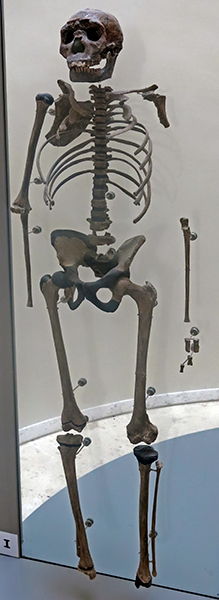
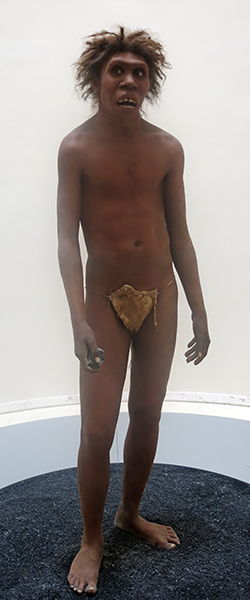
The most famous Homo erectus find is the 'Turkana Boy', KNM WT 15000, circa 1.5 million BP, a young male discovered in Kenya by Kamoya Kimeu in 1984. The original is now kept at the Kenya National Museum.
His reconstructed skeleton - with a narrow pelvis and tall, thin body - is interpreted as showing adaptation to the hot climate and the need to run long distances.
Photo: Don Hitchcock 2014
Source: Display at Musée National de Préhistoire, Les Eyzies
Artist responsible for the hyperrealistic reconstruction of Turkana Boy: Elisabeth Daynès
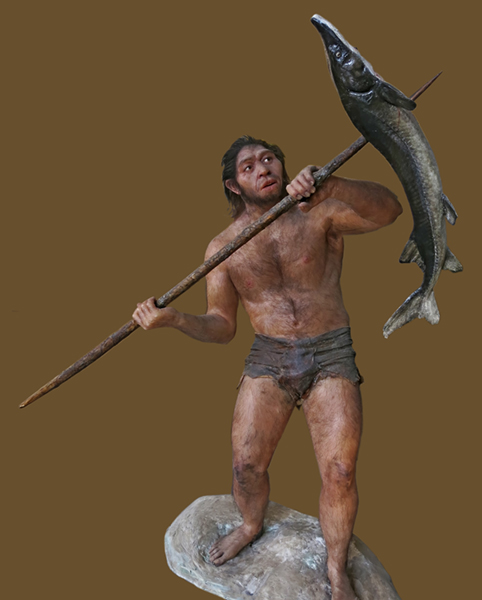
Homo erectus
Soft tissue reconstruction based on the skull reconstruction by G.J. Sawyer & I. Tattersall. They used the Zhoukoudian skull fragments XII, III, XIV/VI, X/I, X/II, the mandible fragments GI/II and the isolated teeth 2, 6, and 13.
Zhoukoudian, China, circa 780 000 BP - 600 000 BP.
Photo: Don Hitchcock 2015
Sculptor: Atelier Élisabeth Daynès, Paris
Source and text: Facsimile, Vienna Natural History Museum, Naturhistorisches Museum Wien
Early Homo erectus appears to inherit Oldowan technology and refines it into the Acheulean handaxe industry beginning 1.7 million years ago.
Homo erectus was the first human ancestor to spread throughout Eurasia, with a continental range extending from the Iberian Peninsula, at Atapuerca, Spain, through Dmanisi, Georgia, to China and Java.
Sangiran on the island of Java, is the most important Homo erectus site in Indonesia. The remains of over 80 individuals have been found here at a number of localities. The region was first occupied about 1.6 million years ago.
The site of Zhoukoudian, 40 kilometres south of Beijing in China, has yielded the largest number of Homo erectus fossils from any one locality (about 50 individuals are represented by the remains). About 100,000 stone tool artefacts were also in the cave. These were mostly quartz and sandstone chopping tools and flakes. It was occupied between 750 000 and 200 000 years ago, although evidence suggests that occupation was sporadic rather than permanent. Hyenas and other animals also used the cave site.
The last known population of Homo erectus is Homo erectus soloensis from Java, around 117 000 – 108 000 years ago.
Text above adapted from Wikipedia and australian.museum
Flakes
It was soon realised that the flakes struck from a river stone could themselves be adapted for various uses. They often have sharp edges, suitable for cutting meat and scraping hides in order to prepare the hides for use as tents and clothing. Some could be held in the hand, while others were best used by attaching a wooden handle of some kind, perhaps by using animal sinew or strips of leather.
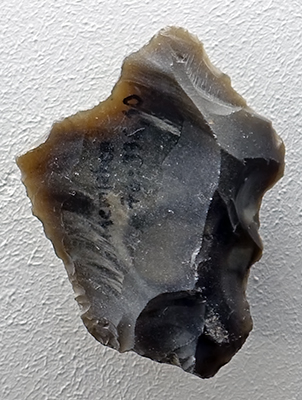
Abschlaggerät, tool on a flake, circa 500 000 BP.
From Memleben, on the Unstrut River, a few kilometres west of Wangen, and approximately 50 km SW of Halle.
Photo: Don Hitchcock 2018
Source and text: Halle Landesmuseum für Vorgeschichte, CC-BY-NC-SA @ State Museum of Prehistory Halle
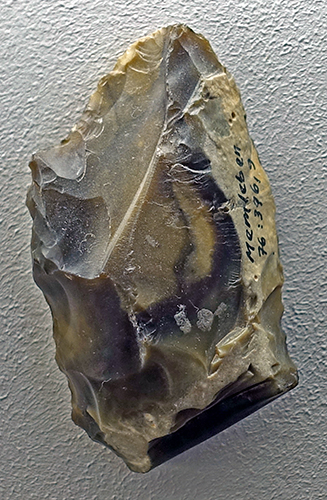
Schaber, scraper, circa 500 000 BP.
It can be seen on this example that the flakes themselves were 'retouched' to alter their shape, and to make a sharp, straight edge.
From Memleben, on the Unstrut River, a few kilometres west of Wangen, and approximately 50 km SW of Halle.
Photo: Don Hitchcock 2018
Source and text: Halle Landesmuseum für Vorgeschichte, CC-BY-NC-SA @ State Museum of Prehistory Halle
Acheulean Hand Axes / Bifaces
Acheulean handaxes are an industry of stone tool manufacture characterised by the distinctive oval and pear-shaped handaxes associated with Homo erectus and derived species such as Homo heidelbergensis.
Acheulean tools were produced during the Lower Palaeolithic era across Africa and much of West Asia, South Asia, East Asia and Europe, and are typically found with Homo erectus remains. It is thought that Acheulean technologies first developed about 2 million years ago, derived from the more primitive Oldowan technology associated with Homo habilis. In Europe and Western Asia, early Neanderthals adopted Acheulean technology, transitioning to Mousterian by about 160 000 BP.
This is a very useful diagram showing various types of Biface (Acheulian) handaxes.
Note that there is very little difference between the Lanceolate and Micoquien profiles, and individual handaxes may be very difficult to assign to one or the other of these two profiles.
Photo: Wikipedia
Acheulean Hand Axe
Cordiform (heart shaped) Profile.
Palaeolithic, circa 500 000 BP
This is a classic quartzite Acheulean handaxe from North Africa, found in a dry watercourse, a small tributary of the Draa river, near Tan Tan,
at N 28.23233, W 10.59947.
Dimensions 220 mm x 115 mm x 60 mm.
Photo: Don Hitchcock 2016
Source: Private collection
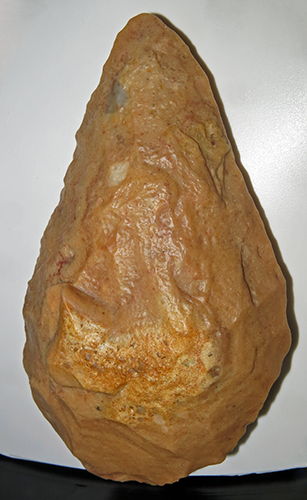
Acheulean Hand Axe
Cordiform (Heart shaped) Profile.
Circa 1 500 000 BP - 300 000 BP, from S'baikia, Algeria.
Photo: Don Hitchcock 2015
Source and text: Original, Monrepos Archäologisches Forschungszentrum und Museum, Neuwied, Germany
Acheulean Hand Axes
Lanceolate Profiles.
Left:
The Gray's Inn Lane Hand Axe is a pointed flint hand axe, found buried in gravel under Gray's Inn Lane, London, England, by pioneering archaeologist John Conyers in 1679. The hand axe is a fine example from about 350 000 years ago, from the Lower Palaeolithic, and probably made by Homo erectus, who made most of these sorts of hand axe.
Photo: © Trustees of the British Museum, CC BY-NC-SA 4.0
Source: https://www.britishmuseum.org/collection/image/10134001, © Trustees of the British Museum, CC BY-NC-SA 4.0
Right:
Another Acheulean hand axe was discovered by John Frere in the 1700s, when he investigated a four metre deep pit (dug by brickworkers) at Hoxne, in England.
Photo: Johnbod
Permission: Creative Commons Attribution-Share Alike 3.0 Unported license.
Bifacial handaxes remained a persistent element of later European toolkits. Notable among these are the well-made bifacial handaxes of the 'Mousterian of Acheulean Tradition', dating to circa 50 000 BP - 70 000 BP and associated with the Neanderthal occupation of Europe. These handaxes are relatively small, well-made, and are usually triangular, sub-triangular, or cordate (almond- or heart-shaped).
Text above adapted from stonetoolsmuseum.com
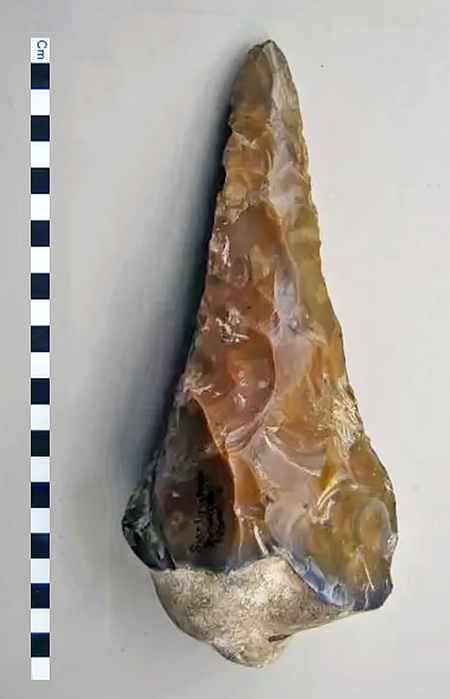
A ficron hand axe of the Acheulean tradition, dating from the Lower Palaeolithic period, originally from the collection of Roy Rainbird Clarke (1914-1963). In plan, the axe is triangular with concave sides, typical of the ficron style of hand axe (Wymer, Mode 2, Type M).
Made on a flint nodule, the flint has been flaked to remove most of the cortex, except for a large patch at the butt end, producing a tapering axe which is lozenge-shaped in section.
The narrow tip has been finely flaked to a point. The surface of the flint is coated with a thick, silky patina which has become a deep orange 'butterscotch' colour by the slow absorption of iron salts over time.
Findspot: Surlingham, Brundall, Norwich
Source, photo and text: https://finds.org.uk/database/artefacts/record/id/898567, © Royal Institution of Cornwall, Portable Antiquities Scheme, The British Museum
Permission: CC BY 2.0
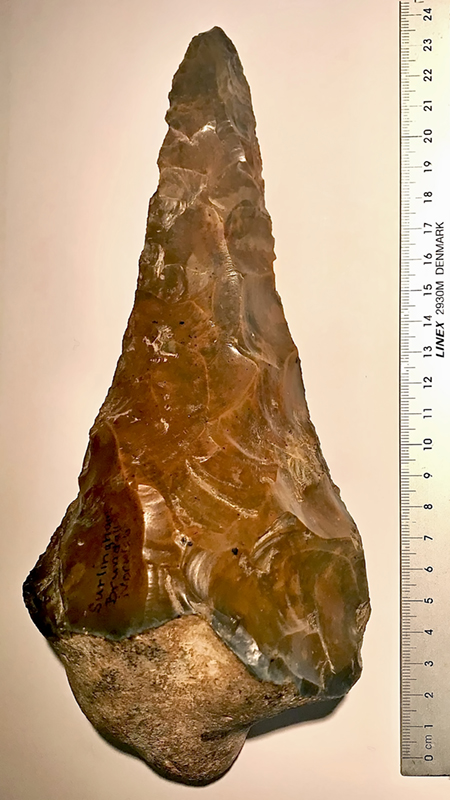
The ficron appears to have been a specialised tool, used by holding the thick butt end in the hand, but its exact function is not known. The earliest evidence of the Acheulean in Britain is a hand axe from Happisburgh, Norfolk which has been dated to 700 000 BP and the tradition continued until around 200 000 BP. Ficron axes are uncommon.
Photo: A high definition photograph courtesy of © Ben Mankowitz
Text: https://finds.org.uk/database/artefacts/record/id/898567, © Royal Institution of Cornwall, Portable Antiquities Scheme, The British Museum, Permission CC BY 2.0
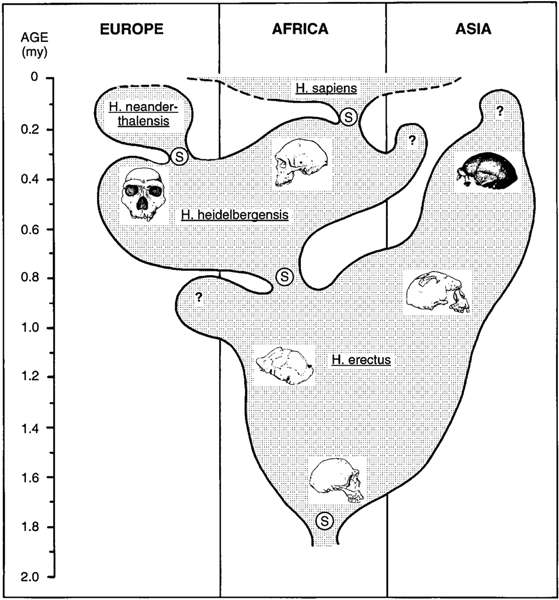
A tree illustrating the evolution and geographic distribution of Homo in the Pleistocene. Homo erectus is assumed to have originated in Africa and then spread quickly to Asia
and then to Europe.
Homo heidelbergensis is distributed from Africa into Eurasia during the Middle Pleistocene. Whether this species reached the Far East is still a question. European
Homo heidelbergensis gave rise to the Neanderthals, while an African branch of Homo heidelbergensis is ancestral to modern humans. Four speciation events (S) are depicted.
Photo and text: Rightmire (1998)
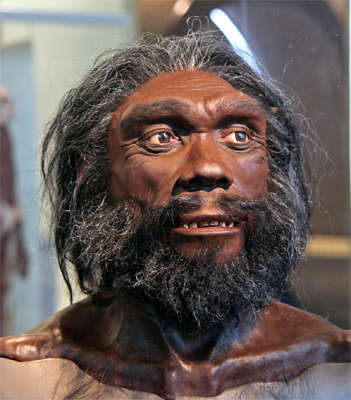
Model of the head and shoulders of an adult male Homo heidelbergensis on display in the Hall of Human Origins in the Smithsonian Museum of Natural History in Washington, D.C., created by John Gurche, a 'paleo-artist,' who has recreated strikingly realistic heads of our earliest human ancestors.
Abigail Tucker, 'A Closer Look at Evolutionary Faces', Smithsonian.com, February 25, 2010 writes:
Appearing 700 000 years ago, Homo heidelbergensis is closely related to our own species. 'It has huge brow ridges,' Gurche notes. 'A lot of people think that’s kind of a shock absorber for the face, that it dissipates pressure put on teeth at the front of the skull, if you are using your mouth as a clamp to grip implements or a skin.'
The huge brow ridges tempted Gurche to create a scowling expression, and in fact he had reason to believe that this particular individual wasn’t a happy camper: the model skull had nearly a dozen abscessed teeth. But 'I happened to catch him in a good mood,' Gurche says. 'I wanted that positive feeling to be somewhere in the line-up.'
Link: https://www.smithsonianmag.com/science-nature/a-closer-look-at-evolutionary-faces-8369070/
Photo: Tim Evanson
Permission: Creative Commons Attribution-Share Alike 2.0 Generic license.
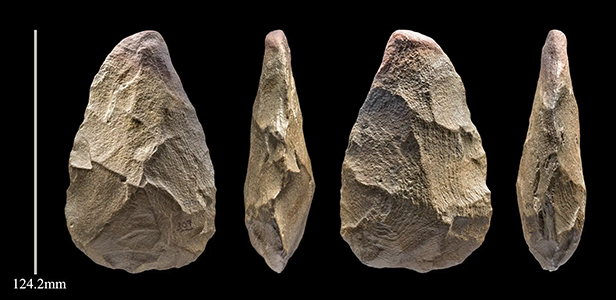
A 400 000 year old handaxe from Khall Amayshan 4 in Arabia, attributed to Homo heidelbergensis.
( note the layering of the material of this handaxe. It may be a variety of silcrete, indurated sandstone - Don )
Photo: Ian Cartwright
Source: Palaeodeserts Project
Stone tools attributed to Homo heidelbergensis from KAM4 and Jebel Umm Sanman 1 (JSM1), at Jubbah, located approximately 90 km northwest of the city of Hail in Arabia.
From left to right:
Assemblage A, KAM4 (approximately 400 000 BP)
Assemblage B, KAM4 (approximately 300 000 BP)
assemblage C, KAM 4 (approximately 200 000 BP)
Assemblage D (Southeast Lake, approximately 125 000 BP – 75 000 BP)
Assemblage E, KAM 4 (approximately 000 BP?)
Scale bar, 1 cm.
( Note the levallois technique examples from Assemblage D. The levallois technique was associated with the hominin populations of (late) Homo heidelbergensis, Homo neanderthalensis, and Homo sapiens - Don )
Photo and text: Groucutt et al. (2021)
Neanderthals
Neanderthals were a distinct group of hominins that lived in Eurasia, overlapping with early Homo sapiens (modern humans) for a significant period.
While modern humans are closely related to the Neanderthals, they are not our direct ancestors. Evidence from the fossil record and genetic data shows they are a distinct species that developed as a side branch in our family tree. Some European Homo heidelbergensis fossils were showing early Neanderthal-like features by about 300 000 years ago and it is likely that Neanderthals evolved in Europe from this species.
Neanderthals were well-adapted to cold climates, with robust bodies, a stocky build, and short limbs that helped conserve heat. They had a large brain size, comparable to or even slightly larger than that of modern humans.
Neanderthals were skilled toolmakers and used a variety of tools. They hunted large game, such as mammoths and bison, and evidence suggests they had sophisticated hunting strategies.
Text above partially adapted from https://australian.museum
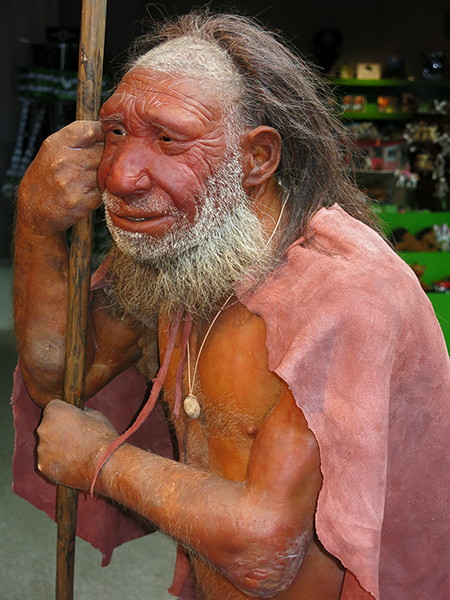
This is a wonderfully true to life sculpture on display at the Neanderthal Museum, Mettman.
It is modelled on the first Neanderthal remains found in the Neander Valley.
The original Neanderthal skeleton from the Neander Valley, the type specimen, dubbed Neanderthal 1, consisted of a skull cap, two femora, three bones from the right arm, two from the left arm, part of the left ilium, fragments of a scapula, and ribs. The workers who recovered this material originally thought it to be the remains of a bear.
They gave the material to amateur naturalist Johann Carl Fuhlrott, who turned the fossils over to anatomist Hermann Schaaffhausen. The discovery was jointly announced in 1857. The original Neanderthal discovery is now considered the beginning of paleoanthropology. These and other discoveries led to the idea these remains were from ancient Europeans who had played an important role in modern human origins. The bones of over 400 Neanderthals have been found since.
Photo: Don Hitchcock 2015
Artist: Kennis & Kennis Reconstructions
Source: Facsimile, Neanderthal Museum, Mettmann, near Düsseldorf
Text: adapted from Wikipedia
The Mousterian is the name given to the archaeological industry of stone tools associated primarily with the Neanderthals in Europe, and to the earliest anatomically modern humans in North Africa and West Asia. The Mousterian largely defines the latter part of the Middle Paleolithic, the middle of the West Eurasian Old Stone Age. It lasted roughly from 160 000 BP to 40 000 BP.
If its predecessor, known as Levallois or Levallois-Mousterian, is included, the range is extended to as early as circa 300 000 BP – 200 000 BP. The main following period is the Aurignacian (circa 43 000 BP – 28 000 BP) of Homo sapiens.
The culture was named after the type site of Le Moustier, three superimposed rock shelters in the Dordogne region of France. Similar flintwork has been found all over unglaciated Europe and also the Near East and North Africa. Handaxes, racloirs, and points constitute the industry; sometimes a Levallois technique or another prepared-core technique was employed in making the flint flakes.
Text above: Wikipedia
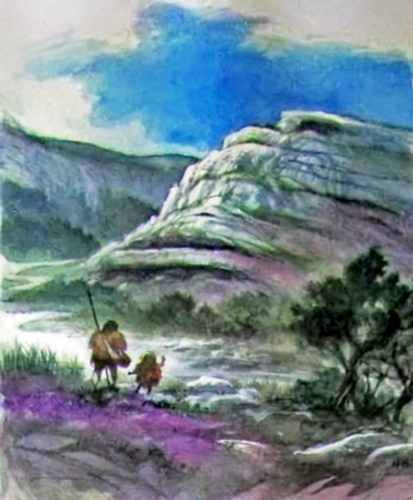
Discovered in the spring of 1908, Moustier 1 was recognised as a Neanderthal burial shortly after the discovery of the old man of la Chapelle-aux-Saints, a few hundred kilometres away.
Excavations at the time, led by Hauser, were poorly done. This fundamental fossil was not properly studied until it was restored in the 1990s.
Text: Adapted and translated from the display at Musée National de Préhistoire, Les Eyzies
Rephotography: Don Hitchcock 2008
Artist:© Emmanuel Roudier, 2008
Superb watercolours were done for this exhibition by the French artist, Emmanuel Roudier.
Blog: http://roudier-neandertal.blogspot.com/ Contact: emmanuelroudier@gmail.com
Source and text: Display at Musée National de Préhistoire, Les Eyzies
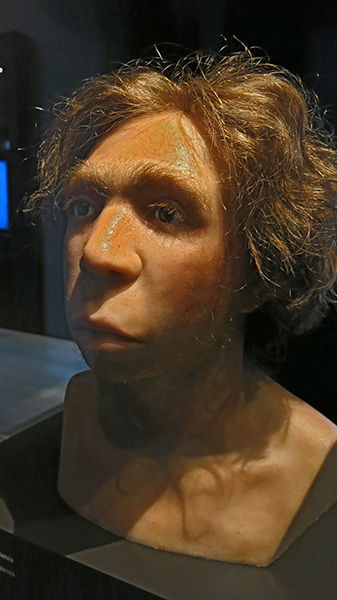
Reconstruction of the adolescent male le Moustier 1, circa 45 000 BP
Production: Manufaktur, München.
Photo: Don Hitchcock 2015
Source and text: Facsimile, Staatliche Museen zu Berlin, Neues Museum, Germany
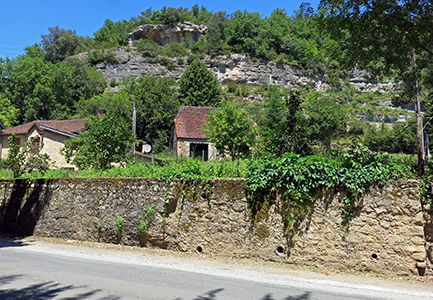
The iconic le Moustier cliff face.
Photo: Don Hitchcock 2014
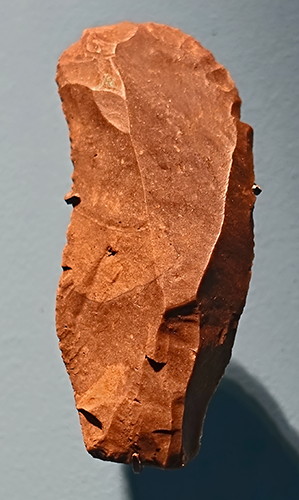
Grattoir, scraper, in flint, from Le Moustier.
Circa 60 000 BP - 40 000 BP
Photo: Don Hitchcock 2018
Collections du Musée national de Préhistoire, Les Eyzies-de-Tayac
Source and text: Musée de l'Homme, Paris
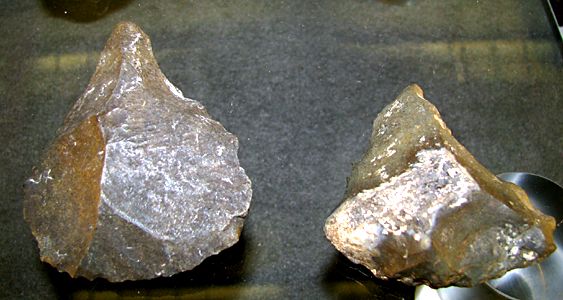
Stone tools from Le Moustier.
Photo: Don Hitchcock 2008
Source: Originals, display at the Vienna Natural History Museum, Naturhistorisches Museum Wien
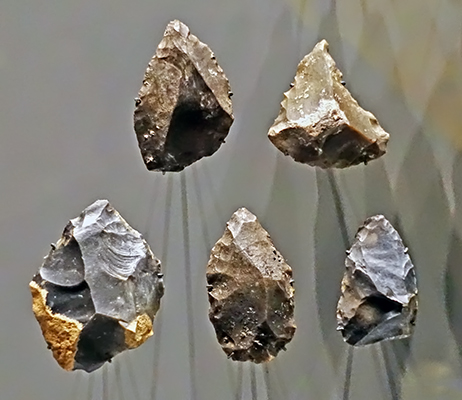
Le Moustier scrapers, Mousterian, 56 000 BP - 40 000 BP
Photo: Don Hitchcock 2018
Source: Museum of Natural History, Vienna
Flint (jasper) tool from Freiburg. Mousterian culture, circa 80 000 BP.
Small Mousterian ovate hand axe / scraper.
Note the large flake taken out for a thumb grip. There are many neanderthal tools (and even some upper palaeolithic tools) with this feature.
The blank was struck from a flint (jasper) core and bifacially worked in the handaxe tradition.
Worked on both sides, this piece still stands in the long tradition of early handaxes, but is characterised by careful restoration of a flat surface. It may have been used as both a scraper and a handaxe.
In the case of fairly small tools such as this, it is often difficult to determine if it is primarily a Breitschaber / Blattschaber (wide / blade scraper) or Faustkeil (hand axe).
It may have been used as a handaxe in the morning, and a scraper that afternoon. Not for nothing is the classic handaxe known as the 'Swiss Army Knife' of Palaeolithic tools. Many millions were made, and used for many purposes - cutting, scraping, smashing bones to obtain the marrow, or choppers for cutting up carcasses or cutting down small trees.
Similar tools are also known from other European sites and are referred to as the Mousterian culture after the French site of 'Le Moustier' (Dordogne / France). This culture was of Neanderthal origin.
Photo and text: Don Hitchcock 2015
Source: Badisches Landesmuseum Karlsruhe Germany
Mousterian of Acheulean tradition (MTA)
The Mousterian of Acheulean tradition (MTA, Moustérien de Tradition Acheuléenne) describes a group of industries characterised by small and finely retouched cordiform (heart shaped) bifaces and by backed knives ( which do not need a handle to be used efficiently - Don ) (Peyrony (1920).
The Mousterian of Acheulean tradition (MTA) is one of the cultural and technological facies of the Mousterian , the main cultural manifestation of the Middle Palaeolithic in Eurasia (around 300 000 BP to 45 000 BP).
It occurs in the western half of France, Belgium, the Netherlands, Wales, and southern and central England.
Different regional variants of the MTA have been distinguished according to the presence of bifaces with a peculiar morphology:
• MTA with triangular bifaces within northern France
• MTA with bout-coupé form unique to Britain
• MTA with cleavers in French Brittany.
Text above adapted from Soressi (2004)
• MTA with triangular bifaces within northern France
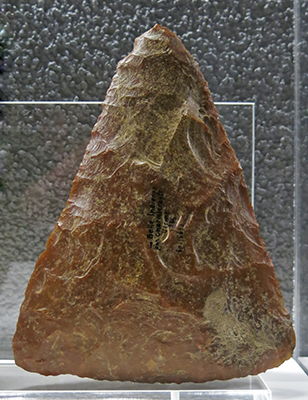
Mousterian biface hand axe, made of flint. This is an important piece from the Department Vienne near Châtellerault (La Belle Indienne), as may be seen from the inscription on the axe.
Length 172 mm, width 126 mm, thickness 27 mm.
This handaxe is seen by many collectors as the non-plus-ultra for the Moustérien de tradition acheuléenne (MTA) bifaces.
Note that at the time of writing the catalog of the museum is in error regarding its origin, ascribing it to Fontmaure (Vienne). My thanks to Katzman of http://www.aggsbach.de/ for the heads up about this important discrepancy. See http://www.aggsbach.de/2016/10/the-ordinary-and-the-special-triangular-handaxes-bifaces/
Katzman writes (pers.comm.) that about 2006 an American collector bought a similar piece at a French auction house for $14 000 USD.
Photo: Don Hitchcock 2015
Additional text and access to Bordes (1979): Katzman of http://www.aggsbach.de/
Catalog: 60.1563.1
Source: Original, Musée d'Aquitaine à Bordeaux
Bout coupé biface handaxes
Bout coupé characteristics:
• rounded tip
• two slightly convex lateral edges
• cutting edge worked around the entire circumference
• a very low position of maximum width
• two clear angles at the intersection of the butt and lateral margins
• straight or slightly convex butt edge
Text above: Karen et al. (2016)
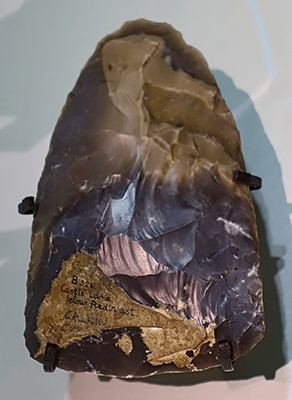
Bout coupé biface flint handaxe
Circa 71 000 BP - 57 000 BP
Marine isotope stage 4, a cold glacial period.
Catalog: B324, Castle Lane below Redbreast, Bournemouth
Photo: Don Hitchcock 2018
On loan from the Trustees of the British Museum
Source and text: Musée de l'Homme, Paris
Cleavers
Cleavers resemble hand axes in that they are large and oblong or U-shaped tools meant to be held in the hand. But, unlike hand axes, they have a wide, straight cutting edge running at right angles to the axis of the tool.
Acheulean cleavers resemble handaxes but with the pointed end truncated away. Flake cleavers have a cutting edge created by a tranchet flake being struck from the primary surface.

Cleaver
Flint cleaver, circa 1 000 000 BP - 300 000 BP (Lower Palaeolithic)
From Griquatown, Northern Cape Province, South Africa.
130 × 85 × 33 mm
Note that while this is not an MTA cleaver, but an earlier Acheulean example, it is important to have a very high resolution image of a cleaver, which are rarely photographed. Cleavers were held in the hand by the butt, and the sharp flat end at right angles to the axis of the tool was brought down on the meat or other material being cut.
Didier Descouens is a master photographer, and has published many thousands of extremely valuable high quality images of tools from museum collections, which he has made freely available.
He is a world treasure.
Photo: Didier Descouens
Permission: Creative Commons Attribution-Share Alike 4.0 International license.
Source: Muséum de Toulouse
Catalog: MHNT PRE.2009.0.197.1
The Levallois (Mousterian) technique
The Levallois technique is a name given by archaeologists to a distinctive type of stone knapping developed around 300 000 BP to 250 000 BP during the Middle Palaeolithic period. It is part of the Mousterian stone tool industry, and was used by the Neanderthals in Europe and by modern humans in other regions such as the Levant.
It is named after 19th-century finds of flint tools in the Levallois-Perret suburb of Paris, France. The technique was more sophisticated than earlier methods of lithic reduction, involving the striking of lithic flakes from a prepared lithic core. A striking platform is formed at one end and then the core's edges are trimmed by flaking off pieces around the outline of the intended lithic flake. This creates a domed shape on the side of the core, known as a tortoise core, as the various scars and rounded form are reminiscent of a tortoise's shell. When the striking platform is finally hit, a lithic flake separates from the lithic core with a distinctive plano-convex profile and with all of its edges sharpened by the earlier trimming work.
This method provides much greater control over the size and shape of the final flake which would then be employed as a scraper or knife although the technique could also be adapted to produce projectile points known as Levallois points. Scientists consider the Levallois complex to be a Mode 3 technology, as a result of its diachronic variability. This is one level superior to the Acheulean complex of the Lower Palaeolithic.
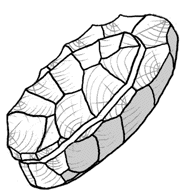
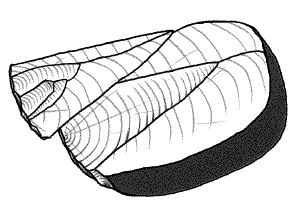
The Levallois (Mousterian) technique animation for a blade (left) and a point (right).
Click on the images to expand and view the animation of how the techniques are performed.
Photo: José-Manuel Benito Álvarez
Permission: licensed under the Creative Commons Attribution-Share Alike 2.5 Generic license.
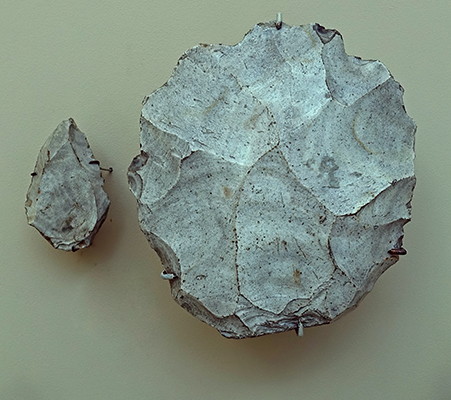
Levallois core (or nucleus) and point.
This core clearly shows the scars of various flakes
struck from it. The most recent is at the bottom centre of the object.
Photo: Don Hitchcock 2018
Source: Original, Anthropos Pavilion/Moravian Museum, Brno, Czech Republic
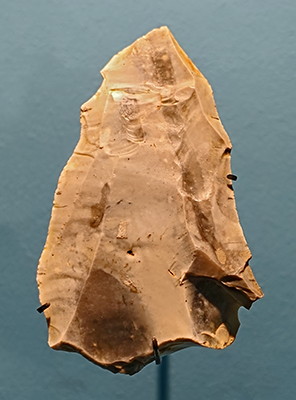
Levallois Point, in flint.
From Therdonne, France
Circa 178 000 BP
Photo: Don Hitchcock 2018
Source and text: Musée de l'Homme, Paris
(left) Levallois flake from Vailly-sur-Aisne, western France, 100 000 BP - 40 000 BP.
(right) Levallois flake from Montières, western France.
Photo: Don Hitchcock 2014
Source and text: Original, Københavns (Copenhagen) Museum, National Museum of Denmark
The Aurignacian
The Aurignacian culture was associated with Homo sapiens, located in Europe and Southeast Asia, which lasted between 47 000 BP and 41 000 BP.
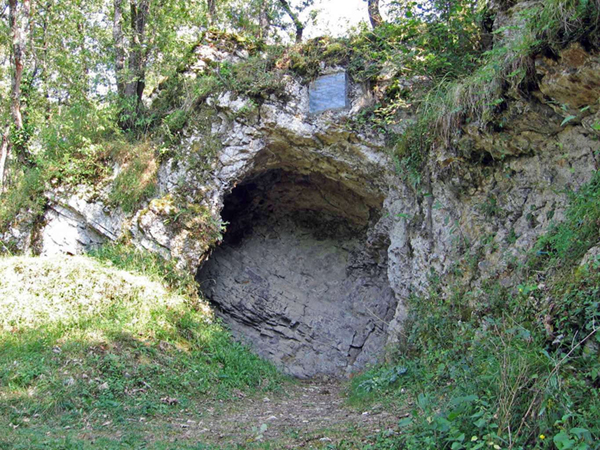
La Grotte d'Aurignac
Photo: Totor-22
Permission: GNU Free Documentation License
La Grotte d'Aurignac is a cave located in the commune of Aurignac, in Haute-Garonne (Midi-Pyrenees , France). Occupied during the Upper Palaeolithic, it gave its name to the Aurignacian, a prehistoric culture of the beginning of that period. The cave is named after the town in which it is located, Aurignac. The cave is now reduced to a small rock-shelter. It is located at the northern end of the town of Aurignac, 1.6 km from the village. The cave was discovered in 1852 by Jean-Baptiste Bonnemaison and studied from 1860 by Édouard Lartet. The cave is very rich archaeologically.
Text above translated and adapted from the French Wikipedia.
Map of Aurignacian culture.
Photo: Hughcharlesparker
Permission: CC-BY-SA-3.0
The Aurignacians are part of the wave of anatomically modern humans thought to have spread from Africa through the Near East into Palaeolithic Europe, and became known as European early modern humans, or Cro-Magnons.
The Aurignacian tool industry is characterised by worked bone or antler points with bases split in a V shape to facilitate attachment to a spear or dart shaft. Their flint tools include fine blades and bladelets struck from prepared cores rather than using crude flakes. The people of this culture also produced some of the earliest known cave art, such as the animal engravings at Trois Freres and the paintings at Chauvet cave in southern France. They also made pendants, bracelets, and ivory beads, as well as three-dimensional figurines. Perforated rods, Bâtons percés, thought to be spear shaft straighteners, or possibly spear throwers or rope making tools, are also found at their sites. They were formerly thought to be bâtons de commandement, a status object for leaders of the group.
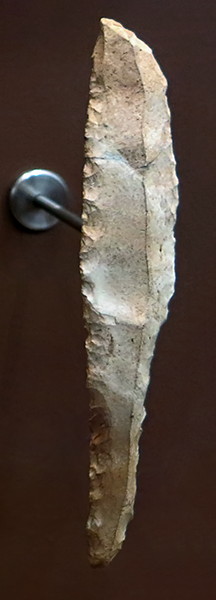
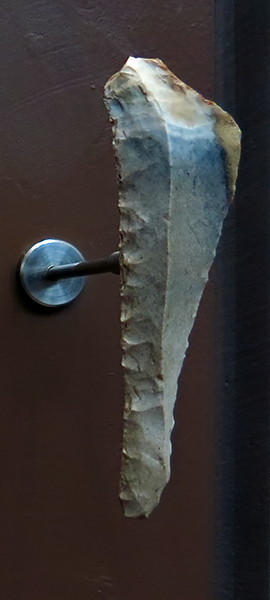
Tools from le Piage layer K.
Protoaurignacian.
Located just 8 kilometres from the Dordogne valley, just north of Gourdon, the Piage deposit is part of a set of caves and shelters opening at the base of an imposing cliff of Coniacian (Late Cretaceous) limestone.
(left) Very long and skilfully made blade, heavily retouched, bearing a great resemblance in general shape to a pointe à cran, or shouldered point. Shouldered points did not make their appearance until much later, in the Gravettian, however. The tip has been modified to serve as a burin.
(right) Double ended burin.
Photo and tool identification: Don Hitchcock 2014
Source: Original, le Musée National de Préhistoire, Les Eyzies-de-Tayac
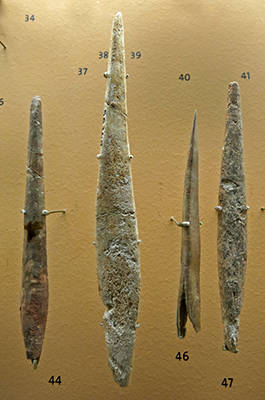
Aurignacian of l'abri Blanchard des Roches à Sergeac, Dordogne
Left and centre right: Sagaie à base fendue, spear point with split base.
Centre left and right: Sagaie losangique, rhombic spearpoint, also characteristic of the Aurignacian.
Photo: Don Hitchcock 2014
Source: Original, Musée d'Archeologie Nationale et Domaine, St-Germain-en-Laye
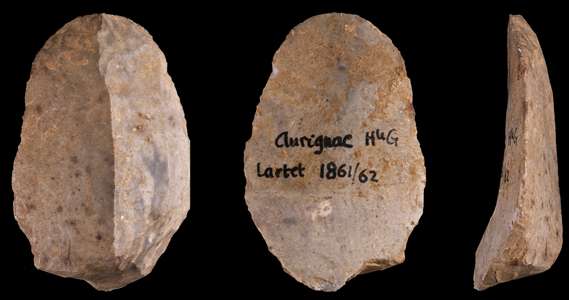
Aurignacian of la grotte d'Aurignac, Haute-Garonne
Aurignacian scraper on a blade, from the type site, Aurignac Cave in Southern France.
Date: between 37 000 and 28 000 BP
Medium: Flint
Current location: Muséum de Toulouse, France
Object history: Findspot: Aurignac cave, Haute-Garonne, France. Former collection of Édouard Lartet, 1861
Photo: Didier Descouens
Permission: Creative Commons Attribution-Share Alike 3.0 Unported license.
Aurignacian of la grotte d'Aurignac, Haute-Garonne
Aurignacian grattoir (end scraper) on a blade, from the type site, Aurignac Cave in Southern France.
( Certainly more flakes than blades were created in the Aurignacian, but the important thing is that blades, an efficient way of making many tools quickly from a prepared core, became far more common in the Aurignacian - Don )
Date: between 37 000 and 28 000 BP
Medium: Flint
Current location: Muséum de Toulouse, France
Object history: Findspot: Aurignac cave, Haute-Garonne, France. Former collection of Édouard and Louis Lartet, 1860
( Louis Lartet was Édouard Lartet's son, and at first a student of his. Louis later discovered the Cro-Magnon 1 man, one of the first fossil hominins to be recognised as a modern human, and went on to become a professor of Geology at the University of Toulouse - Don )
Photo: Don Hitchcock 2015
Source: Original, Muséum de Toulouse, France
Additional text: Wikipedia
Blades from la grotte d'Aurignac, retouched to form grattoirs, end scrapers.
The Aurignacian was the first Upper Palaeolithic culture, 37 000 BP - 28 000 BP.
The Aurignacian culture occupied vast regions of Europe (amongst other places) during intensely cold climates and brief temperate periods. They invented new technical skills, particularly in flint knapping as well as in the use of bones and antlers.
They were the first artists to express themselves almost solely with painting or engraving animals, cupules and vulvas, in stone and wood.
Photo: Don Hitchcock 2014
Source and text: Original, Musée d’art et d’archéologie du Périgord, Périgueux
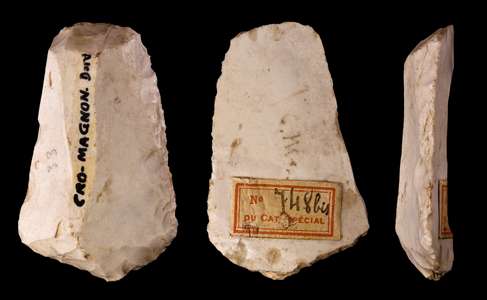
Double edged scraper on a blade from the Cro-Magnon Shelter.
Date: Aurignacian, ca. 45 000 - 35 000 BP
Medium: flint
Dimensions: 47 × 30 × 12 mm (1.9 × 1.2 × 0.5 in) Weight: 15.9 g (0.56 oz)
Current location: Muséum de Toulouse, Accession number MHNT PRE.2010.0.95.3
Findspot: Cro-Magnon, Les Eyzies-de-Tayac-Sireuil, France, collection of Louis Lartet
Photo: Didier Descouens, 2011-03-30
Permission: This file is licensed under the Creative Commons Attribution-Share Alike 3.0 Unported license.
Aurignacian burins, Grotte de Jolias, Prignac-et-Marcamps (33) and Laussel Marquay (24)
Flint, Inv. No. 60.913.8 and 61.3.85
Photo: Don Hitchcock 2015
Source: Original, Musée d'Aquitaine à Bordeaux
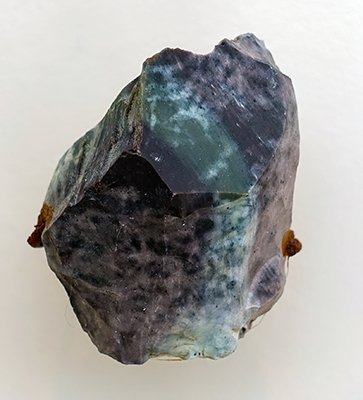
This is a typically shaped core of the Aurignacian, from which many blades have been struck.
Photo and text: Don Hitchcock 2018
Source: Original, Anthropos Pavilion/Moravian Museum, Brno, Czech Republic
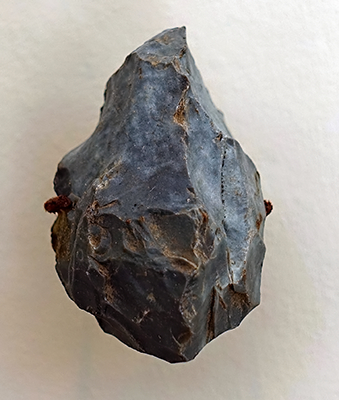
The burin was invented by the Aurignacians, and made fine engravings and small sculptures of ivory and stone possible. This type is generally known as a Burin Busqué, or beaked burin, and here is made on a flake.
Photo and text: Don Hitchcock 2018
Source: Original, Anthropos Pavilion/Moravian Museum, Brno, Czech Republic
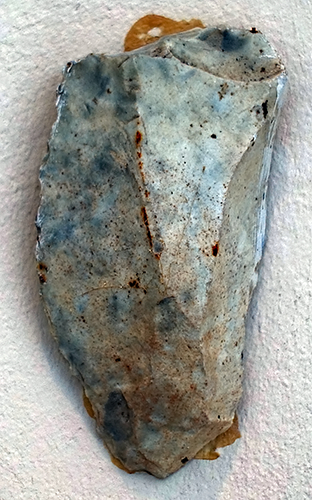
This (now broken) blade has been made into a backed knife, one of the most common blade tools of the Upper Palaeolithic.
One side of the blade has been steeply retouched by pressure flaking, to allow it to be held in the hand, with the index finger on the dulled side, in order to cut with the opposite sharp edge. They were about as good as a steel knife for skinning an animal, though of course they had many other uses.
Photo and text: Don Hitchcock 2018
Source: Original, Anthropos Pavilion/Moravian Museum, Brno, Czech Republic
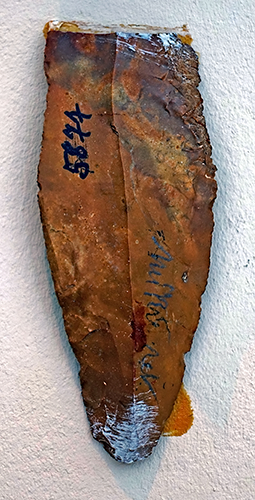
This beautifully made blade has been reshaped and steeply retouched at the upper end, possibly to accept a leather or wooden handle.
The rest of the knife has been finely pressure flaked along its length to resharpen it.
Photo and text: Don Hitchcock 2018
Source: Original, Anthropos Pavilion/Moravian Museum, Brno, Czech Republic
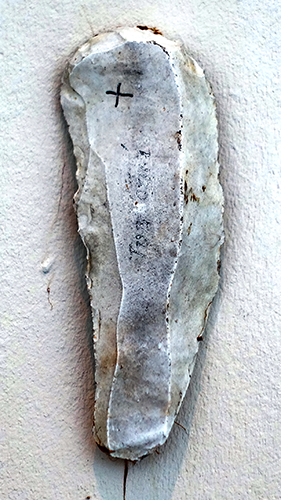
The invention of blade technology, where many long, thin, and sharply edged blades could be struck quickly and easily from a prepared core created a huge increase in the range of tools which could be made. This grattoir, or end scraper, is a case in point. The sides have been steeply retouched to blunt them, so that it could be held in the hand.
Photo and text: Don Hitchcock 2018
Source: Original, Anthropos Pavilion/Moravian Museum, Brno, Czech Republic
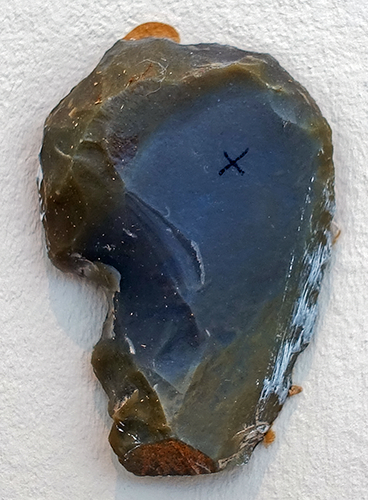
This scraper has been made on a flake, and has been turned into a notched scraper in order to smooth spear shafts as well as normal side and nosed scraper usage.
Photo and text: Don Hitchcock 2018
Source: Original, Anthropos Pavilion/Moravian Museum, Brno, Czech Republic
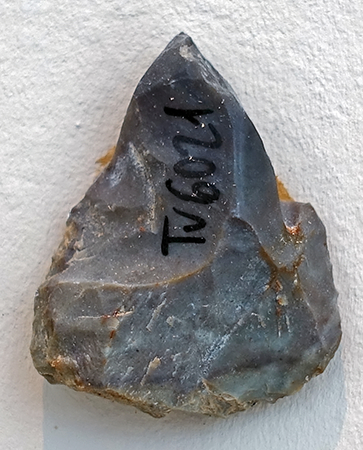
This burin might best be described as a carinate or keeled burin, but it has similarities to the Paviland burin of the late Aurignacian.
Photo and text: Don Hitchcock 2018
Source: Original, Anthropos Pavilion/Moravian Museum, Brno, Czech Republic
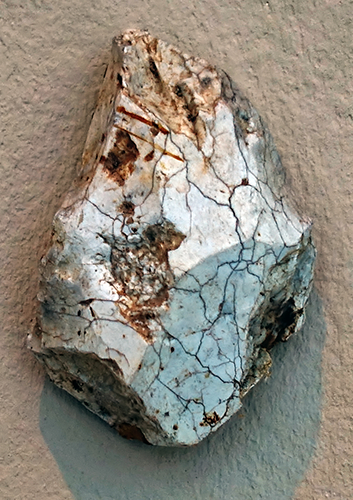
A beaked burin in desperate need of resharpening.
Photo and text: Don Hitchcock 2018
Source: Original, Anthropos Pavilion/Moravian Museum, Brno, Czech Republic
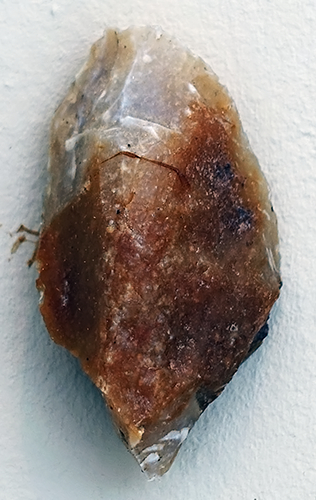
A carinate or keeled tool, with a scraper on one end and a burin on the other.
Photo and text: Don Hitchcock 2018
Source: Original, Anthropos Pavilion/Moravian Museum, Brno, Czech Republic
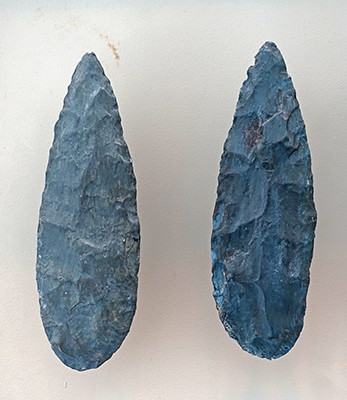
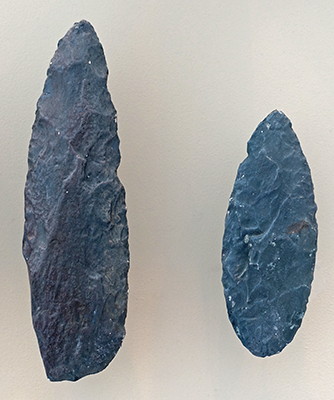
At Szeleta Cave in the Bukových (Bükk, Beech) Mountains, leaf shaped spear heads have been found. In Slovakia, Szeletien locally excludes the Aurignacien, although the Carpathians were alternately visited by hunters of both cultures.
( note that these laurel leaf spear heads are usually indicative of the Solutrean culture, not the Aurignacian - Don )
Photo: Don Hitchcock 2018
Source and text: Facsimile, Anthropos Pavilion/Moravian Museum, Brno, Czech Republic
The Gravettian
The Gravettian toolmaking culture is named after the type site of La Gravette in the Dordogne region of France where its characteristic tools were first found and studied. It dates from between 28 000 and 22 000 years ago. Artistic achievements of the Gravettian cultural stage include the hundreds of Venus figurines, which are widely distributed in Europe.
The Gravettian succeeded the Aurignacian. It is archaeologically the last European culture many consider unified, and had mostly disappeared by circa 22 000 BP, close to the Last Glacial Maximum of around 20 000 BP. In Spain and France, it was succeeded by the Solutrean, but it developed into or continued as the Epigravettian in Italy, the Balkans, Ukraine and Russia.
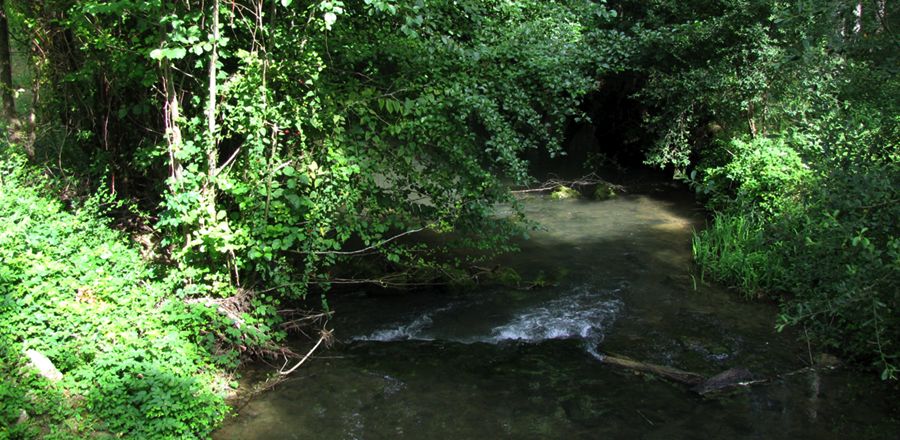
The site of La Gravette is in the valley of the Couze River, a pretty little stream.
Photo: Don Hitchcock 2008
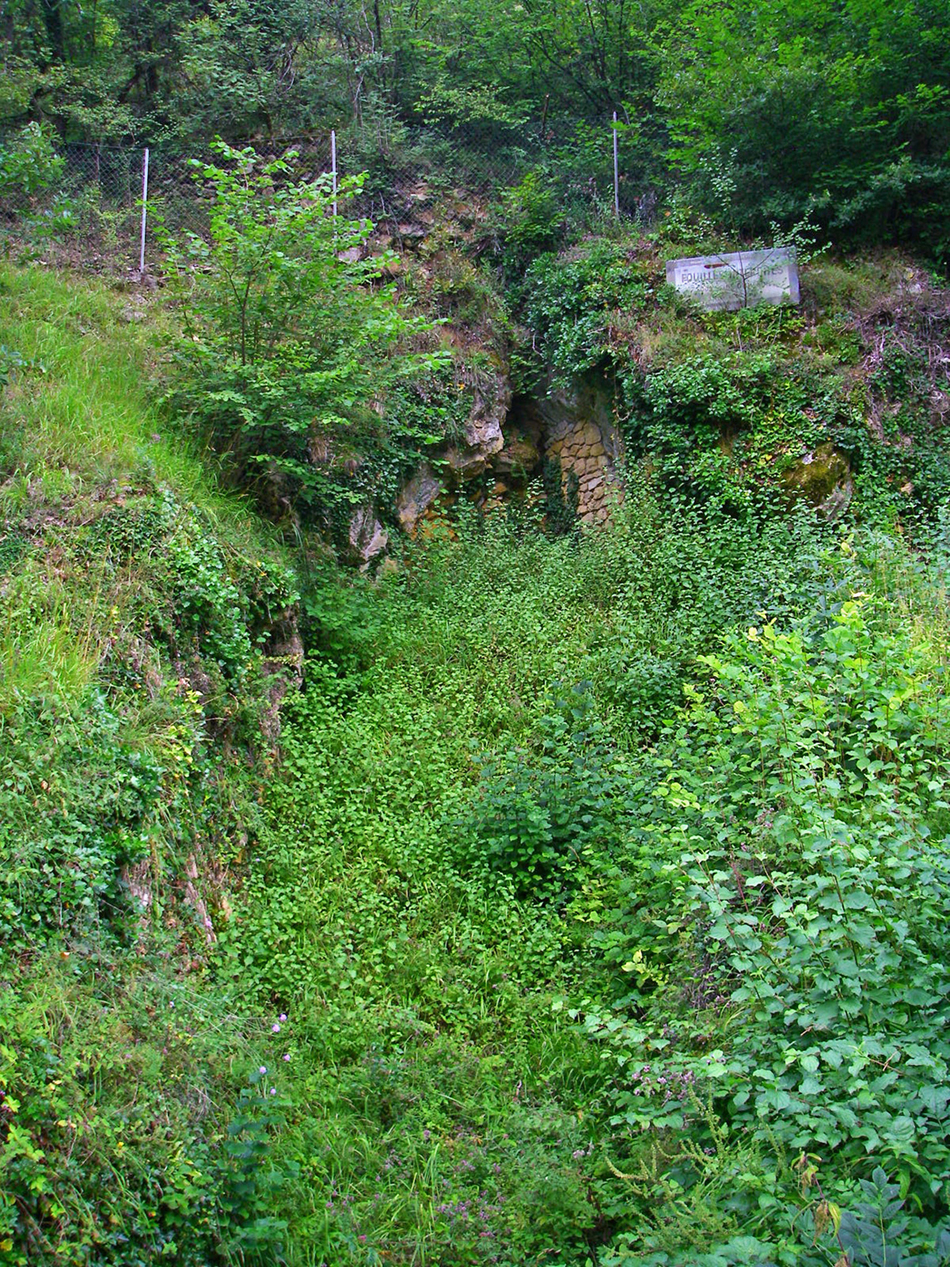
The gisement, or archeological site of La Gravette is not easy to find, and has no identification as to its significance as the type site for the Gravettian culture.
The site is quite overgrown. It has not been touched for fifty years because of a condition of its donation to the state.
Photo: Don Hitchcock 2008
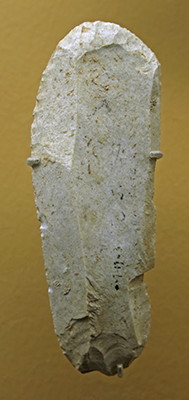
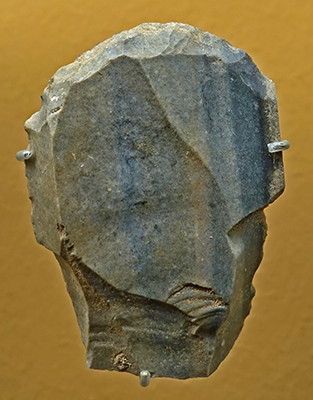
Gravettien of l'abri de la Gravette à Bayac, Dordogne
Grattoirs, scrapers.
Photo: Don Hitchcock 2015, 2018
Source: Original, Musée d'Archeologie Nationale et Domaine, St-Germain-en-Laye
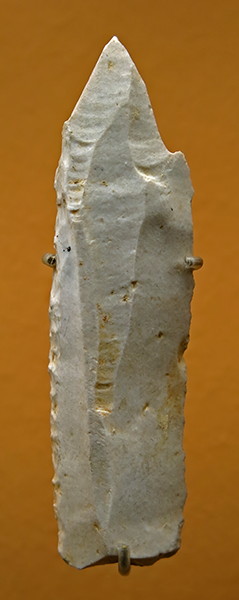
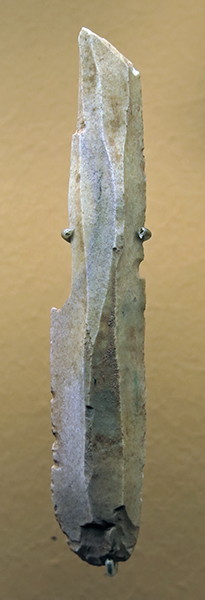
Gravettien of l'abri de la Gravette à Bayac, Dordogne
Burins.
( note that the burin on the right is very long, and appears to have had an even longer burin spall than now exists when originally made. A notch has been placed on the right hand edge of this burin - Don )
Photo: Don Hitchcock 2015
Source: Original, Musée d'Archeologie Nationale et Domaine, St-Germain-en-Laye

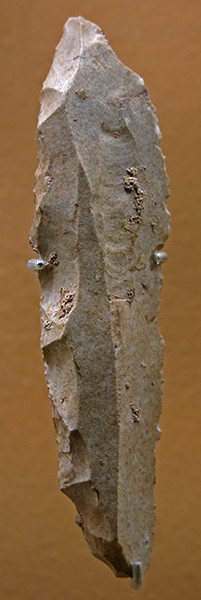

Gravettien of l'abri de la Gravette à Bayac, Dordogne
Gravettian points.
Photo: Don Hitchcock 2015
Source: Original, Musée d'Archeologie Nationale et Domaine, St-Germain-en-Laye




Gravettien of l'abri de la Gravette à Bayac, Dordogne
Gravettian points.
Photo: Don Hitchcock 2015, 2018
Source: Original, Musée d'Archeologie Nationale et Domaine, St-Germain-en-Laye
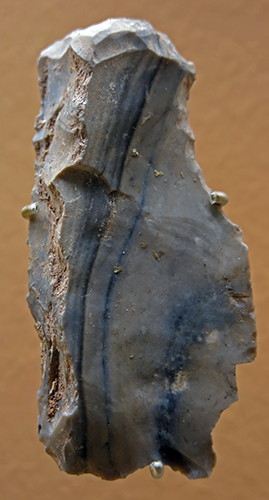
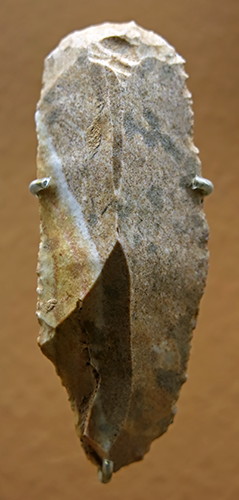
Bayacien of l'abri de la Gravette à Bayac, Dordogne
Note that the 'Bayacien' underlies the Gravettian but is closely associated with it.
Grattoirs, scrapers.
Photo: Don Hitchcock 2015
Source: Original, Musée d'Archeologie Nationale et Domaine, St-Germain-en-Laye
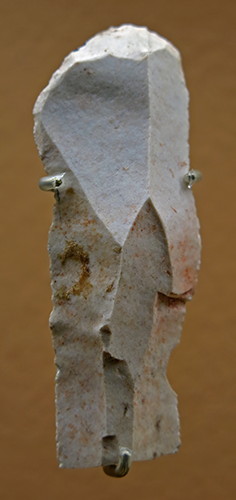
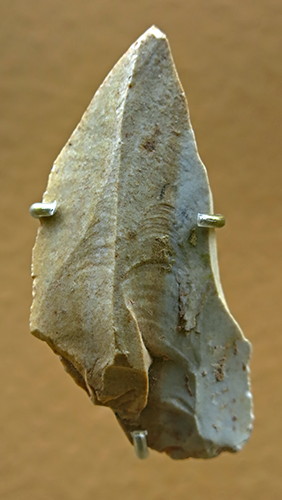
Bayacien of l'abri de la Gravette à Bayac, Dordogne
Note that the 'Bayacien' underlies the Gravettian but is closely associated with it.
(left): Grattoir, scraper.
(right): Burin
Photo: Don Hitchcock 2015
Source: Original, Musée d'Archeologie Nationale et Domaine, St-Germain-en-Laye
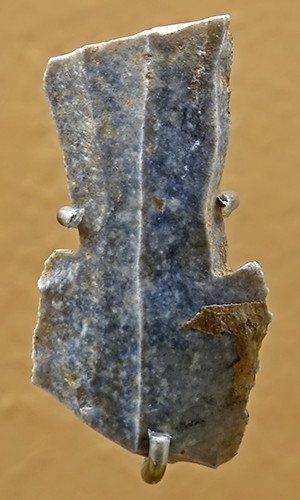

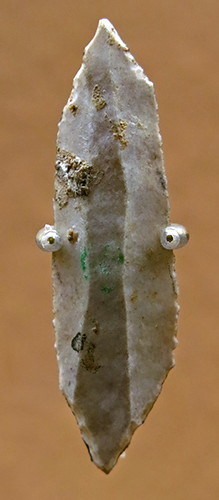
Bayacien of l'abri de la Gravette à Bayac, Dordogne
Note that the 'Bayacien' underlies the Gravettian but is closely associated with it.
From left: Burin de Noailles, fléchettes.
Photo: Don Hitchcock 2018, 2015, 2015
Source: Original, Musée d'Archeologie Nationale et Domaine, St-Germain-en-Laye
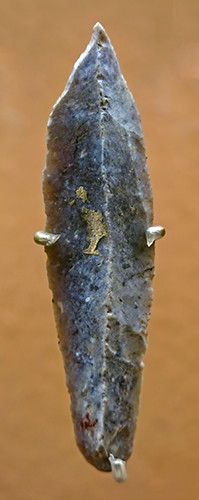
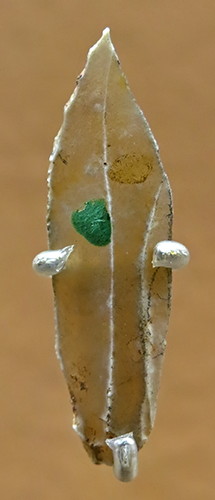

Bayacien of l'abri de la Gravette à Bayac, Dordogne
Note that the 'Bayacien' underlies the Gravettian but is closely associated with it.
Fléchettes.
Photo: Don Hitchcock 2015
Source: Original, Musée d'Archeologie Nationale et Domaine, St-Germain-en-Laye

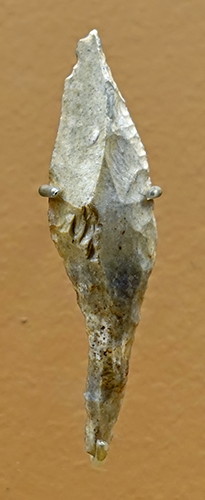
Font-Robert points.
Photo: Don Hitchcock 2015, 2018
Provenance: Unknown
Source: Musée d’art et d’archéologie du Périgord, Périgueux
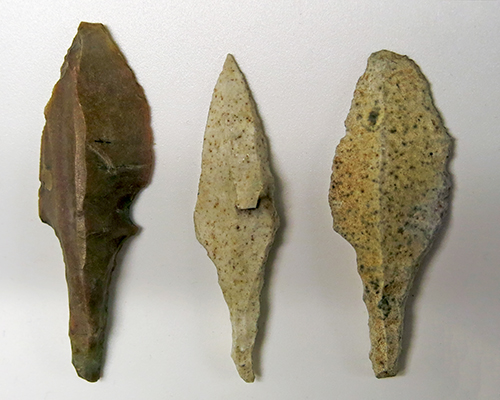
Pointes de la Font-Robert, Font-Robert points, Les Bertranoux, Creysse (24).
Font-Robert points are tanged points with a leaf‐shaped blade, flat on one side, and convex on the other. They are worked on one face only.
Period: Gravettian
Flint, Inv. no. 60.351.1, 61.3.22, 61.3.28
Photo: Don Hitchcock 2015
Source: Original, Musée d'Aquitaine à Bordeaux
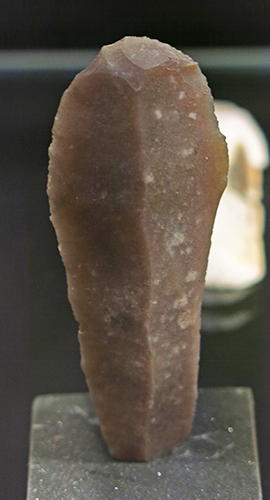
A very fine quality scraper from la Gravette.
Photo: Don Hitchcock 2014
Source: Musée d’art et d’archéologie du Périgord, Périgueux
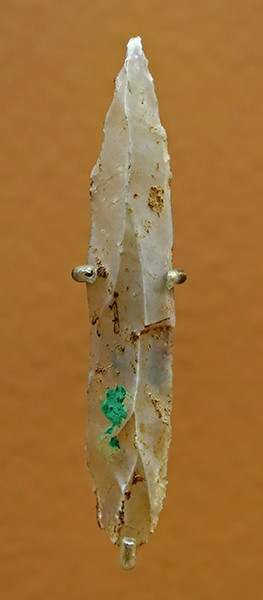
Flint fléchette from La Gravette.
Dimensions: length 59 mm, width 4 mm, depth 1 mm.
Catalog: MAN77325
Photo: Don Hitchcock 2015
Source: Original, Musée d'Archeologie Nationale et Domaine, St-Germain-en-Laye
Text: https://www.photo.rmn.fr/
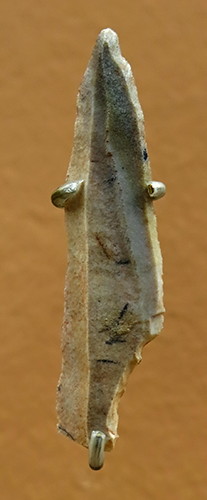
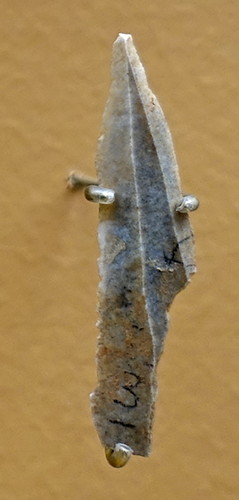
Gravettian shouldered points, pointes à cran.
(left): Shouldered point from La Gravette.
Dimensions: 50 mm long, 12 mm wide, 3 mm thick, Catalog MAN82126
Photo: Don Hitchcock 2015, 2018
Source: Original, Musée d'Archeologie Nationale et Domaine, St-Germain-en-Laye
Text: https://www.photo.rmn.fr/
Grattoirs, La Gravette, Bayac (24).
Period: Gravettian
Flint, Inv. no. 60.455.1, 61.3.27
Photo: Don Hitchcock 2015
Source: Original, Musée d'Aquitaine à Bordeaux
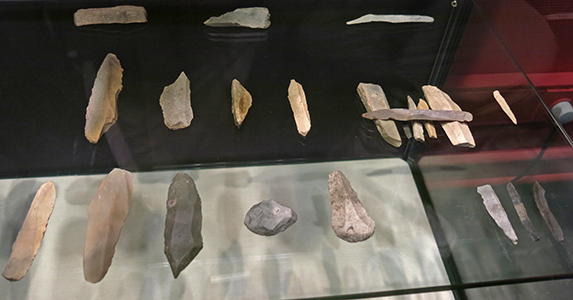
Burins, scrapers, and Gravette points.
Photo: Don Hitchcock 2014
Source: Musée d’art et d’archéologie du Périgord, Périgueux

Burin, La Gravette, Bayac (24)
Catalog: 60.455.9
Photo: Don Hitchcock 2015
Source: Original, Musée d'Aquitaine à Bordeaux
Pointes de la Gravette, Gravette points, La Gravette, Bayac (24) and Laussel, Marquay (24).
Period: Gravettian
Flint, Inv. no. 16,23, 60.1057.1, 61.3.23
Photo: Don Hitchcock 2015
Source: Original, Musée d'Aquitaine à Bordeaux
Perçoir, drill, Laussel, Marquay (24).
( This is a very specialised, large drill, possibly used to create the hole in a bâton percé. Most are much smaller, obviously used for creating tiny holes in shell or ivory - Don )
Period: Gravettian
Flint, Inv. no. 61.3.24
Photo: Don Hitchcock 2015
Source: Original, Musée d'Aquitaine à Bordeaux
Poinçon, awl, Laussel, Marquay (24).
Period: Gravettian
Bone, Inv. no. 61.3.216
Photo: Don Hitchcock 2015
Source: Original, Musée d'Aquitaine à Bordeaux
Lissoir, Laussel, Marquay (24).
( The slender, curved implements called lissoirs were shaped from (often) deer ribs and used to work animal hides to make them softer, tougher and more waterproof. The tools exploit particular features of bone, such as its toughness and flexibility. Lissoirs could not be made from a hard and brittle material like stone, because it would damage the leather and risk snapping in the user's hand. But made from bone, the tool would flex as it was pressed onto a hide.
The three almost circular marks on the lissoir are probably from the original identification labels, removed after the three parts of the tool were glued together. The lissoir was broken in antiquity, since the ends have been eroded by soil biota - Don )
Period: Gravettian
Bone, Inv. no. 61.3.184
Photo: Don Hitchcock 2015
Source: Original, Musée d'Aquitaine à Bordeaux
Saggaies, spear points, Laussel, Marquay (24).
Period: Gravettian
Bone, Inv. no. 61.3.212, 61.3.218, 61.3.219
Photo: Don Hitchcock 2015
Source: Original, Musée d'Aquitaine à Bordeaux
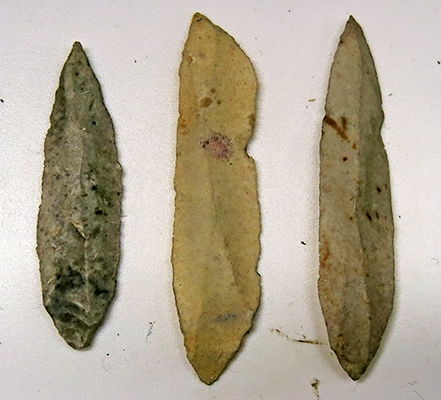
Fléchettes from la Gravette.
Catalog: 60.455.34, 60.455.35, 60.455.36
Photo: Don Hitchcock 2015
Source: Original, Musée d'Aquitaine à Bordeaux


(left): Gravettian spear point in reindeer antler from la grotte d'Isturitz.
Dimensions: length 106 mm, width 10 mm.
Catalog: MAN75255F1
(right): Gravettian spear point in reindeer antler from la grotte d'Isturitz.
Dimensions: length 86 mm, width 11 mm, thickness 5 mm.
Catalog: MAN83889
Photo: Don Hitchcock 2015, 2018
Source: Original, Musée d'Archeologie Nationale et Domaine, St-Germain-en-Laye
Text: https://www.photo.rmn.fr

Gravettian age microgravettes from la Gravette.
These microliths are slightly larger than the geometric microliths that followed, and were made from the flakes of flint obtained ad hoc from a small nucleus or from a depleted nucleus of flint.
Photo: Don Hitchcock 2015
Text: Adapted from Wikipedia
Catalog: 60.455.31 to 60.455.33, 61.3.185, 61.3.192
Source: Original, Musée d'Aquitaine à Bordeaux
References
- Ackerl, I., 2009: History of Austria in dates : From prehistoric times to 1804, marixverlag , 20 Feb 2009 - History - 224 pages
- Bednarik, R., 1995: Concept-mediated marking in the Lower Palaeolothic, Current Anthropology, 36, p. 605-634.
- Bohmers A., 1951: Die Höhlen von Mauern. Teil I. Kulturgeschichte der Altsteinzeitlichen Besiedlung, Palaeohistoria 1 p. 1–107
- Bordes F., 1979: Typologie du Paleolithique ancien et moyen, Paris: Editions du Centre national de la recherche scientifique.
- Delagnes A., 2000: Blade production during the Middle Paleolithic in Northwestern Europe, ACTA Anthropologica Sinica, Supplement to Volume 19, 2000, pp181-188
- Ehlers J. et al., 2011: Pleistocene glaciations of North Germany - new results, Developments in Quaternary Science, 15. Elsevier, Amsterdam, pp. 149-162.
- Ertmer S., 2010: Die Parkkiesgrube Hundisburg - ein klassischer Fundplatz der Altsteinzeit im Lichte neuer Ausgrabungen, Archäologie in Sachsen-Anhalt , SSonderband 13 · 2010
- Ertmer S., 2010b: https://uni-tuebingen.de/fakultaeten/mathematisch-naturwissenschaftliche-fakultaet/fachbereiche/geowissenschaften/arbeitsgruppen/urgeschichte-naturwissenschaftliche-archaeologie/forschungsbereich/aeltere-urgeschichte-quartaeroekologie/forschung/grabungen/deutschland/hundisburg/
- Flas D., 2012: Jerzmanowice points from Spy and the issue of the Lincombian-Ranisian- Jerzmanowician, Anthropologica et Praehistorica, January 2012, 123(1):217-230
- Haidle M., Pawlik A., 2010: The earliest settlement of Germany: Is there anything out there?, Quaternary International, 223-224 (2010) 143 - 153
- Hoffecker J., 2009: The spread of modern humans in Europe, Proc Natl Acad Sci USA, 2009 Sep 22; 106(38): 16040–16045
- Hülle W., 1977: Die Ilsenhöhle unter Burg Ranis / Thüringen, Fischer, 1977, ISBN-10: 343730254X, ISBN-13: 978-3437302541, 203 pp.
- Jahn M., 1951: Ein neues Altsteinzeitgerät aus Barleben, Jahresschrift für mitteldeutsche Vorgeschichte, 35 , S. 5 ff. - Halle 1951
- Karen R., Rebecca M., Wragg S., 2016: Spatio-temporal variation in late Middle Palaeolithic Neanderthal behaviour: British bout coupé handaxes as a case study, Quaternary International, Volume 411, Part A, 8 August 2016, Pages 305-326
- Küßner M., Terberger T., 2006: Die Fundstelle Gera-Zoitzberg und die Zeit zwischen Gravettien und Magdalenien in Mitteldeutschland, Alt-Thüringen, 39:69-119
- Groucutt, H., et al., 2021: Multiple hominin dispersals into Southwest Asia over the past 400 000 years, https://doi.org/10.1038/s41586-021-03863-y September 2021
- Lang J., Lauer T., Winsmann J., 2018: New age constraints for the Saalian glaciation in northern central Europe: Implications for the extent of ice sheets and related proglacial lake systems, Quat. Sci. Rev., 180: 240 - 259
- Mania D., 1975: Stratigraphie ökologie und Paläolithikum des Weichselfrüglazials im Mittleren Elbe-Saale-Gebiet, Światowit, 34, 81-138, 1975
- Mania D., 1981: Eine Fundstelle des Perigordien/Gravettien von Bilzingsleben (Kreis Artern, DDR). in: Prehistoire de Ia grande Plaine de I'Europe, Archaeologia lnterregionalis 1, 89-93. Krakau/ Warschau.
- Mania D., 1991: The zonal division of the lower palaeolithic open-air site Bilzingsleben, Anthropologie, XXIX/1-2
- Mania D., 1995: The earliest occupation of Europe: the Elbe- Saale region (Germany), in: Roebroeks W., van Kolfschoten T. (eds) The earliest occupation of Europe, Analecta Leidensia (Leiden) 1995, 85-101.
- Mania D., 2004: Königsaue - hunters at Lake Aschersleben 80,000 years ago, in: Meller, H. (ed.) Paleolithic and Mesolithic. Catalogs for the permanent exhibition in the State Museum of Prehistory Halle, Vol. 1 Halle (Saale), 175-196. Halle (Saale)
- Moreau J. et al., 2012: The glaciogenic unconformity of the southern North Sea, Glaciogenic Reservoirs, Geological Society of London, vol 368. Special Publication, pp. 99-110.
- Moreau, L., 2012: The Aurignacian of Breitenbach, status of flake production, Flakes not Blades, Wissenschaftliche Schriftendes Neanderthal Museums 5, Mettmann 2012
- Moreau, L., 2012b: Breitenbach-Schneidemühle, Germany: A major Aurignacian open air settlement in Central Europe, Eurasian Prehistory, 9(1-2): 51-75.
- Peyrony, D., 1920: Le Moustérien - ses faciès, Association Française pour l’avancement des Sciences, 44th session, Strasbourg, p. 1-2.
- Picin A., 2016: Short-term occupations at the lakeshore: a technological reassessment of the open–air site Königsaue (Germany), Quartär, Volume 63, pp 7-32, DOI: 10.7485/QU63_1
- Richter J., 2009: The role of leaf points in the Late Middle Palaeolithicof Germany, Praehistoria, 9-10 (2008-2009) 99-113
- Richter J., 2016: Leave at the height of the party: A critical review of the Middle Paleolithic in Western Central Europe from its beginnings to its rapid decline, Quaternary International, Volume 411, Part A, 8 August 2016, Pages 107-128, https://doi.org/10.1016/j.quaint.2016.01.018
- Rightmire G., 1998: Human evolution in the Middle Pleistocene: The role of Homo heidelbergensis, Evol. Anthropol., 6: 218–227. doi: 10.1002/(SICI)1520-6505(1998)6:6<218::AID-EVAN4>3.0.CO;2-6
- Sauer D., 2012: From the Northern Ice Shield to the Alpine Glaciations, Geozon Science Media, 2012
- Soressi M., 2004: From the Mousterian of Acheulian Tradition type A To type B: a change in technical tradition, raw material, task, or settlement dynamics? Settlement dynamics of the Middle Palaeolithic and Middle Stone Age, vol. 2, N. Conard (Ed), Tübingen Publications in Prehistory, Tübingen: 343-366
- Toepfer V., 1961: Die altpaläolithischen Feuersteinwerkzeuge von Hundisburg, Jahresschrift für mitteldeutsche Vorgeschichte, 45, 1961, 35−69.
-
Weber T., 2004: The 'Bagger Paläolithikum' in the Middle Elbe-Saale area, in Meller, H. (ed.), Paleolithic and Mesolithic , Catalogs for the permanent exhibition in the State Museum of Prehistory Halle Bd. 1 Halle (Saale), 113-118.
- Weiss M., Lauer T., Wimmer R., Cornel M. , 2018: The Variability of the Keilmesser-Concept: a Case Study from Central Germany, Journal of Paleolithic Archaeology, (2018) 1:202–246 https://doi.org/10.1007/s41982-018-0013-y
- Winsemann J. et al., 2011: Depositional architecture and palaeogeographic significance of Middle Pleistocene glaciolacustrine ice marginal deposits in northwestern Germany: a synoptic overview, E&G Quat. Sci. J. , 60, 212-235.
- Zilhão J., 2014: The Upper Palaeolithic of Europe, The Cambridge World Prehistory. Volume 3,West and Central Asia and Europe, Cambridge University Press, Editors: Colin Refrew, Paul Bahn
- Zupancich A. et al., 2015: On Quina and demi-Quina scraper handling: Preliminary results from the late Lower Paleolithic site of Qesem Cave, Israel, Quaternary International, (2015), http://dx.doi.org/10.1016/j.quaint.2015.10.101

